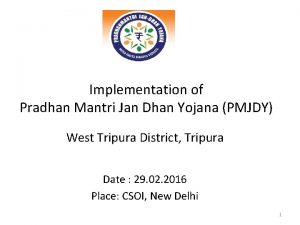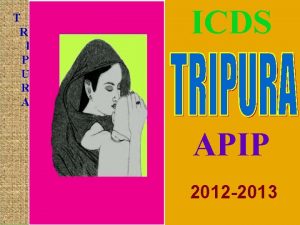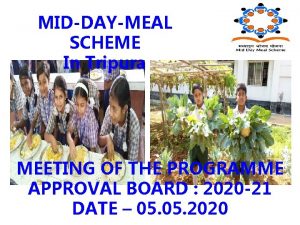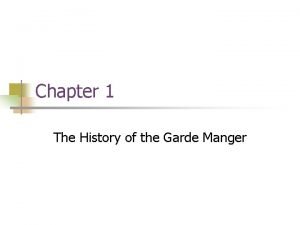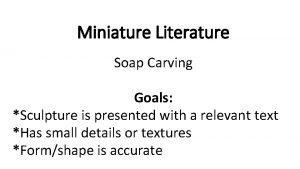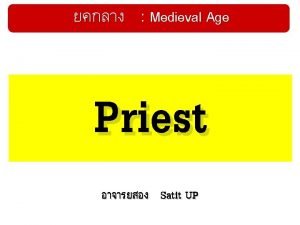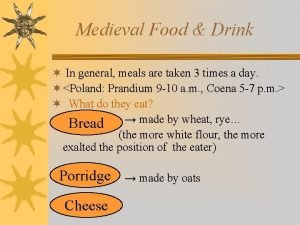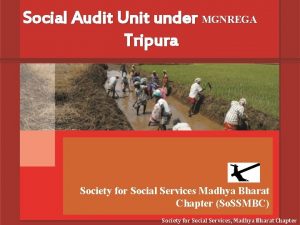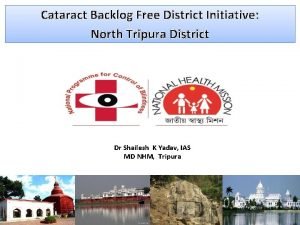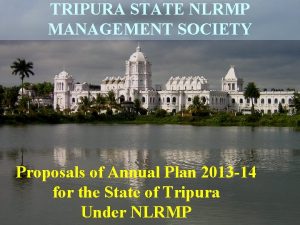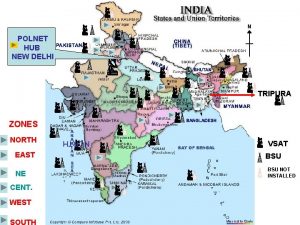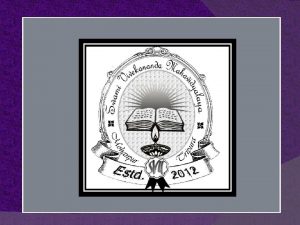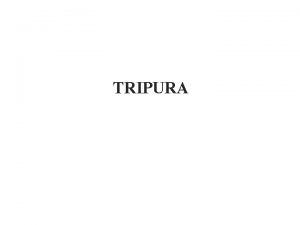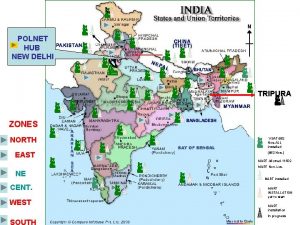Administration under Manikya during Medieval Tripura Dr Lalrinnunga

















- Slides: 17

Administration under Manikya during Medieval Tripura Dr. Lalrinnunga Hmar Assistant Professor Dept. of History Govt. Degree College, Kanchanpur

• • • Ancient Period Myth and Legends Founded by Druhyu- Lunar dynasty Pratisthanpur was his capital His descendant named Daitya came to , Kirata Desha’ Tribeg in present Nowgong district of Assam His son was Tripura, he begot Trilochan married to daughter of Cachar king

According to Rajmala • Nowgong district of upper Assam to Cachar, then to Dharmanagar near Juri river and then to Rangamati

The search for ‘Tripura’ • It is very difficult to find any recorded source which provides information on the origin of the term ‘Tripura’ 1) According to TH. Lewin, “ The origin of the name Tiperrah is doubful” 2) Vedas, Upanishad, Ramayan, Mahabharata, and Puranas do not mention at all. 3) Prior to the Muslim rule in Bengal, Tripura was politically not considered as state.

• Archaeological evidences revealed that south-western part of present Tripura were under eastern kingdoms like Samatata, Vanga and Harikela • Copper plate grant of Samatata kingdom mentions that some part of Tripura were under their feudatory chiefs. • Hiuen Tsang visited Kamrup in 642 -43 AD and did not mention Tripura.

• From the outset Tripura king accepted the suzerainty of sultan of Bengal and used to provide them elephant. Even Rajmala tells us that in the early 15 th Century, Ratna Pha occupied throne of Tripura with the help of Sultan of Gaur.

Medieval period • Process of state formation began during Manikya ruler after defeating other tribes namely Jamatia, Kuki, Reang etc. • During the time of Ratna Pha, (contemporary of Ghiasuddin Balban) they changed their title into Manikya. • Title was given by Muslim ruler after he defeated Mughisuddin Tughril

• In the early 15 th century Rangamati was annexed and become their capital. Udai Manikya changed the name to Udaipur.

Kingship and form of Govt. • In the early 15 th century, Ratna Pha brought three Bengalis named Bara Khandab Ghosh, Pandit Raj and Joynarayan Sen for his important officials. • Bengali and Persian were used as official language. • The administration had three distinct features of Hindu, Muslim and Tribal.

• Acc to Rajmala, distance/ newly conquered province were ruled by Laskars, eg Kailashahar. They were like provincial governor having very high power in their areas. • Pha/ Manikya were at the top, assisted by nobles known as Narayans. • Narayans were close relative of kings through blood. They possessed an army. • Law and order were given due importance

• Land Grant to Brahmins • Dharma Manikya I and Dhanya Manikya were great patron of art and literature. • Important officials were Suba, Uzir or Minister, Nazir, Diwan, Yubraj, Barthakur, Thakur. Suba: Commander-in-chief, normally from royal family. Uzir or Minister: incharge of Revenue Dept Nazir: Incharge of Police- maintenance of law and order.

• Diwan: Incharge of finance dept. Generally hereditary in nature. Bengalis were normally appointed. But Krishna Manikya appointed two Diwan- one to his relative. • Yubraj: crown prince- he will be king in future. Look after revenue, soldier and elephant. • Barthakur: Next to Yubraj. He had to collect elephant from forest. This post was created by Ramdev Manikya (1673 -82 AD) • Thakur: Princess who could not become King. They held important powerful post in administration. Their status was almost similar with nobles.

• Plains and adjoining areas of the capital were divided into several Parganas, headed by Choudhury. Far areas and new territory were ruled by Laskars. In new territory, military base called Thana were created look after by official called Thanader. • Justice: No codified law. Rulers were the judges. No permanent jail. Severe offerder were beheaded. • Source of income: Revenue from the plains. Tribute in the form of elephant and forest product from the tribal chiefs. Currency system was used. Only house tax was collected from the hills. Tavernier- Tripura king had gold mine and silk factory. • Tribal chief

• Army: Very important. Large army. Acc to Abul Fazl, Vijay Manikya possessed 20000 footmen, 1000 elephants. • Acc to Rajmala, Vijay Manikya recruited ten thousand Afghan horse soldier, and have 5000 speed boats. • Comander-in-chief must were from Tripuri tribe, generally blood relative of kings from Narayan level.

• The royal army were consisted of four limbs like infantry, cavalry, navy and elephants. • Main weapon were sword, bow arrow, pointed poisoned bamboo poles and other indigenous weapons. • Michip: actual meaning is coordinator, interpreter. These official were sellected from the rank of Thakur to serve as co-ordinator between king and tribal chief. Michip provided food and lodging to the tribal leader who visited the capital. He listened their grievances.

• Hasham Bhojan: Annual royal feast at the capital. All tribal chiefs and leaders were invited and entertain them at the time of Durga puja in October. It was a grand occasion and dialogues were exchanged between the king and his subjects.

Thank you
 Pradhan mantri krishi sinchayee yojana in tripura
Pradhan mantri krishi sinchayee yojana in tripura Icds tripura
Icds tripura Mid day meal scheme in tripura
Mid day meal scheme in tripura Garde manger history
Garde manger history Oviedo medieval
Oviedo medieval Makeup for theatre
Makeup for theatre Soap literature
Soap literature Castell medieval parts
Castell medieval parts What are the characteristics of a medieval romance?
What are the characteristics of a medieval romance? Medieval english translator
Medieval english translator Commerce medieval
Commerce medieval Medieval architecture
Medieval architecture Hierarchy middle ages
Hierarchy middle ages Structure of medieval society
Structure of medieval society Quaritis
Quaritis Medieval times drink menu
Medieval times drink menu Medieval crime and punishment facts
Medieval crime and punishment facts Conflito abertura e rotatividade
Conflito abertura e rotatividade
